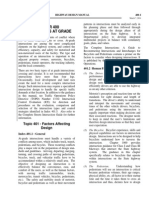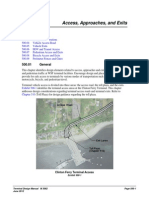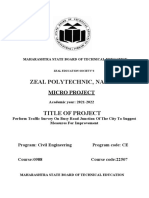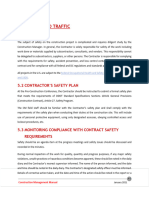All Way Stop Signs FAQs
All Way Stop Signs FAQs
Uploaded by
highwayCopyright:
Available Formats
All Way Stop Signs FAQs
All Way Stop Signs FAQs
Uploaded by
highwayCopyright
Available Formats
Share this document
Did you find this document useful?
Is this content inappropriate?
Copyright:
Available Formats
All Way Stop Signs FAQs
All Way Stop Signs FAQs
Uploaded by
highwayCopyright:
Available Formats
All Way Stop Signs FAQs
FAQ: Can I request an All Way Stop sign?
If there are issues at a specific intersection related to traffic volume, safety, sight distance, or other traffic, pedestrian, or
bicycle based concerns, residents should submit a completed DDOT Traffic Assessment - Application, and specifically
state the issues that warrant the installation of All Way Stop signage. Based on the information provided, DDOT will
investigate the intersection by observing conditions in the field and collecting data. DDOT will then evaluate which
solutions would best address the specific issues, and provide alternative improvements where necessary.
FAQ: What are criteria used for installing an All Way stop sign?
In compliance with federal and local federal law, DDOT has adopted the Federal Highway Administration's (FHWA)
Manual on Uniform Traffic Control Devices (MUTCD) as the official standard for traffic signs, traffic signals, pavement
marking, and traffic control devices. (DCMR 18-2100). In all instances, the decision to install All Way Stop signage must
be based on an engineering study performed according to the national criteria established by the Federal Highways
Administration’s (FHWA) Manual on Uniform Traffic Control Standards (MUTCD); specifically, §2B.07: Multi-way Stop
Applications. However, in some instances, an engineering study may deem the installation of All Way Stop signage
necessary for conditions and situations not expressly stated in the MUTCD.
FAQ: Why does one block have one and not mine?
There are a number of reasons why All Way Stop signage may be warranted and provided at one intersection but not at
an adjacent location, such as differences in volume, crash data, intersection geometry, etc.
FAQ: If All Way Stop signage is not warranted, does DDOT use
other options to calm traffic?
Absolutely. While All Way Stop signage may not be the best solution to address traffic concerns at a specific intersection,
DDOT will consider and implement all beneficial, feasible, and viable solutions. Based on the information obtained from
a Traffic Calming Assessment – Application, DDOT will evaluate the specific issue and provide a solution tailored to that
concern.
District Department of Transportation 55 M Street, SE, Suite 400 Washington, DC 20003
You might also like
- AASHTO Roadside Design Guide 4th Ed 2011 PDFDocument316 pagesAASHTO Roadside Design Guide 4th Ed 2011 PDFRenukadevi Rpt85% (34)
- Traffic Impact AssessmentDocument6 pagesTraffic Impact AssessmentArah Louise Apostol50% (2)
- Traffic Signal FAQsDocument1 pageTraffic Signal FAQshighwayNo ratings yet
- Background On Autonomous and Connected VehcilesDocument4 pagesBackground On Autonomous and Connected VehcilesUsman FarooqNo ratings yet
- Traffic Signals: Finish Crossing If StartedDocument16 pagesTraffic Signals: Finish Crossing If StartedAnonymous PuEyutLNo ratings yet
- MUTCD - Roadway Pavement MarkingsDocument65 pagesMUTCD - Roadway Pavement MarkingshighwayNo ratings yet
- MUTCD - Roadway Pavement Markings R2Document65 pagesMUTCD - Roadway Pavement Markings R2gin singNo ratings yet
- FINAL MDOT Ped Crosswalk Guide March 2020Document22 pagesFINAL MDOT Ped Crosswalk Guide March 2020Herminio Lagran CarinoNo ratings yet
- RWIS and MDSS Economic Value ToolDocument8 pagesRWIS and MDSS Economic Value Toolwumingjian23No ratings yet
- General Purpose Automatic Survey: Dept of ECE, AIEMS 2012Document16 pagesGeneral Purpose Automatic Survey: Dept of ECE, AIEMS 2012santoshnaik264No ratings yet
- Pavement_Friction_Management_T5040_38Document5 pagesPavement_Friction_Management_T5040_38Ivellisse QuinonesNo ratings yet
- Toward V2I Communication Technology-Based Solution For Reducing Road Traffic Congestion in Smart CitiesDocument6 pagesToward V2I Communication Technology-Based Solution For Reducing Road Traffic Congestion in Smart Citiesmohamed salamaNo ratings yet
- Application For Traffic Control DevicesDocument9 pagesApplication For Traffic Control Devicesmexicou208No ratings yet
- January, 2001 Road Design Manual (Metric) 10-0Document44 pagesJanuary, 2001 Road Design Manual (Metric) 10-0thanzawtun1981No ratings yet
- NTSB Letter To NHTSA Feb. 1, 2021Document15 pagesNTSB Letter To NHTSA Feb. 1, 2021CNBC.comNo ratings yet
- Traffic Control Plan (TCP) Submittal GuidelinesDocument4 pagesTraffic Control Plan (TCP) Submittal GuidelineshighwayNo ratings yet
- BTD Signal Policy 5-19-2023Document14 pagesBTD Signal Policy 5-19-2023Mohamed Abdelbasit Abo KaffNo ratings yet
- ECE 5218 Urban Traffic Management Lecture 4Document23 pagesECE 5218 Urban Traffic Management Lecture 4Brian MutethiaNo ratings yet
- Highway Design ManualDocument45 pagesHighway Design Manualnaconnet100% (1)
- Design IntersectionDocument211 pagesDesign Intersectionsuaddad100% (2)
- Bridge Vehicle Impact AssessmentDocument7 pagesBridge Vehicle Impact AssessmentPablo Ruiz AndujarNo ratings yet
- Wisconsin MUTCDDocument90 pagesWisconsin MUTCDthomasmarquardtNo ratings yet
- Toll Plaza: 510.01 GeneralDocument13 pagesToll Plaza: 510.01 GeneralFatmah El WardagyNo ratings yet
- National Cooperative Highway Research Program Projects in The Fiscal Year 2015 ProgramDocument65 pagesNational Cooperative Highway Research Program Projects in The Fiscal Year 2015 ProgramSugiyarto TNNo ratings yet
- 5 CounterMeasuresDocument32 pages5 CounterMeasuresEbisa AdamuNo ratings yet
- FMVSS Considerations For Vehicles With Automated Driving SystemsDocument630 pagesFMVSS Considerations For Vehicles With Automated Driving Systemsyaotao1429No ratings yet
- Transportation Research Forum: DisclaimerDocument21 pagesTransportation Research Forum: DisclaimerAnish PanchalNo ratings yet
- Best PracticesDocument328 pagesBest PracticesDIEGO TUNARROSANo ratings yet
- Safe System Roadway Design HierarchyDocument38 pagesSafe System Roadway Design HierarchyAli AbdoNo ratings yet
- Access, Approaches, and Exits: 500.01 GeneralDocument12 pagesAccess, Approaches, and Exits: 500.01 GeneralJohn Ray Esmama CalasicasNo ratings yet
- Chapter6f r1Document76 pagesChapter6f r1Mugilan SelvarajuNo ratings yet
- Traffic Calming Design GuideDocument46 pagesTraffic Calming Design GuidepaolacromeroaNo ratings yet
- Including Revision 1 Dated May 2012Document5 pagesIncluding Revision 1 Dated May 2012Slim ShadyNo ratings yet
- Safety For RoadsDocument28 pagesSafety For RoadsNISARNo ratings yet
- NHTSA Releases AEB System Requirements To Be Implemented by 2029Document317 pagesNHTSA Releases AEB System Requirements To Be Implemented by 2029Maria MeranoNo ratings yet
- Vehicle ViewDocument7 pagesVehicle ViewGautam DemattiNo ratings yet
- Conepte PT Stabilirea Deciziilor in Ingineria de TraficDocument8 pagesConepte PT Stabilirea Deciziilor in Ingineria de TraficAmariei MihaiNo ratings yet
- Real-Time Advanced Warning and Traffic Control Systems For Highway Work ZonesDocument10 pagesReal-Time Advanced Warning and Traffic Control Systems For Highway Work ZonesrahulsundaresanNo ratings yet
- Supplemental Signs & Traffic Control DevicesDocument4 pagesSupplemental Signs & Traffic Control DevicesJoel D. MillerNo ratings yet
- Zeal Polytechnic, Narhe: Micro ProjectDocument12 pagesZeal Polytechnic, Narhe: Micro ProjectOmkar DeshpandeNo ratings yet
- Intersection AnalysisDocument58 pagesIntersection Analysisovidiuchirvase100% (2)
- Nhtsa Rule 051311Document32 pagesNhtsa Rule 051311api-22054992No ratings yet
- Deep Learning Sensor Fusion For Autonomous VehicleDocument34 pagesDeep Learning Sensor Fusion For Autonomous VehicleGeorges ZaarourNo ratings yet
- Massdot Highway Division January 2012Document77 pagesMassdot Highway Division January 2012Larg FlarvdenNo ratings yet
- MDOT SHA OOS Bridge Railing ManualDocument31 pagesMDOT SHA OOS Bridge Railing Manualantonio111aNo ratings yet
- Automated Vehicle Safety Consortium™ Best PracticeDocument17 pagesAutomated Vehicle Safety Consortium™ Best PracticePHANI MEHER GANTINo ratings yet
- Guide To Traffic Impact Assessment - Arizona USADocument14 pagesGuide To Traffic Impact Assessment - Arizona USATalha AslamNo ratings yet
- Cavite State University: Don Severino de Las Alas CampusDocument13 pagesCavite State University: Don Severino de Las Alas CampusMigz EscutinNo ratings yet
- Vol24No02 032010Document14 pagesVol24No02 032010Irmali FrancoNo ratings yet
- D.C. Crash Data Policy Paper (July 2015)Document5 pagesD.C. Crash Data Policy Paper (July 2015)wamu885No ratings yet
- Orlin Eputy: MemorandumDocument31 pagesOrlin Eputy: MemorandumPlanning DocsNo ratings yet
- A Novel Methodology For Traffic Monitoring and Efficient Data Propagation in Vehicular Ad-Hoc NetworksDocument10 pagesA Novel Methodology For Traffic Monitoring and Efficient Data Propagation in Vehicular Ad-Hoc NetworksInternational Organization of Scientific Research (IOSR)No ratings yet
- Parking AnalysisDocument31 pagesParking AnalysisWaqas Muneer KhanNo ratings yet
- Sae Technical Paper Series: Song You, Mark Krage and Laci JalicsDocument13 pagesSae Technical Paper Series: Song You, Mark Krage and Laci JalicslelamedaNo ratings yet
- Pte Finals ReviewerDocument5 pagesPte Finals ReviewerELIZABETH SISTONANo ratings yet
- Application of Highway Safety Manual To Italia - 2012 - Procedia - Social and BeDocument10 pagesApplication of Highway Safety Manual To Italia - 2012 - Procedia - Social and BeTONY VILCHEZ YARIHUAMANNo ratings yet
- Transpo Group 7 ReportDocument33 pagesTranspo Group 7 ReportZyrill NavarroNo ratings yet
- CIV3703 Transport Engineering (USQ)Document66 pagesCIV3703 Transport Engineering (USQ)hao baiNo ratings yet
- Traffic Enforcement Camera: Advancements in Computer Vision for Traffic Enforcement CamerasFrom EverandTraffic Enforcement Camera: Advancements in Computer Vision for Traffic Enforcement CamerasNo ratings yet
- Highway-Rail Grade Crossing Identification and Prioritizing Model DevelopmentFrom EverandHighway-Rail Grade Crossing Identification and Prioritizing Model DevelopmentNo ratings yet
- ATS-3465 Coloured SurfacingsDocument13 pagesATS-3465 Coloured SurfacingshighwayNo ratings yet
- 1 - Design of SlabsDocument2 pages1 - Design of SlabshighwayNo ratings yet
- ATS-5335 Normal Class ConcreteDocument13 pagesATS-5335 Normal Class ConcretehighwayNo ratings yet
- ATS5620 Cold Applied Sealant JointsDocument11 pagesATS5620 Cold Applied Sealant JointshighwayNo ratings yet
- ATS-5840 Supply Installation Bridge BarriersDocument8 pagesATS-5840 Supply Installation Bridge BarriershighwayNo ratings yet
- ATS-3130 Supply of Aggregate For AsphaltDocument13 pagesATS-3130 Supply of Aggregate For AsphalthighwayNo ratings yet
- ATS-2285 Supply of Strip Filter and Subsurface Drainage PipeDocument10 pagesATS-2285 Supply of Strip Filter and Subsurface Drainage PipehighwayNo ratings yet
- ATS-5880 Fibre Reinforced Polymer Bridge MembersDocument13 pagesATS-5880 Fibre Reinforced Polymer Bridge MembershighwayNo ratings yet
- ATS-2280 Horizontal DrainsDocument8 pagesATS-2280 Horizontal DrainshighwayNo ratings yet
- ATS 2160 23 - GeotextilesDocument14 pagesATS 2160 23 - GeotextileshighwayNo ratings yet
- 4 - Other Information SignsDocument18 pages4 - Other Information SignshighwayNo ratings yet
- 5 - Regulatory SignsDocument28 pages5 - Regulatory SignshighwayNo ratings yet
- Excavations and Restorations (Utility Lines) - 2020Document13 pagesExcavations and Restorations (Utility Lines) - 2020highwayNo ratings yet
- DDOT CM Manual Section 5Document3 pagesDDOT CM Manual Section 5highwayNo ratings yet
- Quality Auditing - Derek Taylor (SDCC)Document6 pagesQuality Auditing - Derek Taylor (SDCC)highwayNo ratings yet
- Traffic Engineering ManualDocument239 pagesTraffic Engineering ManualhighwayNo ratings yet











































































